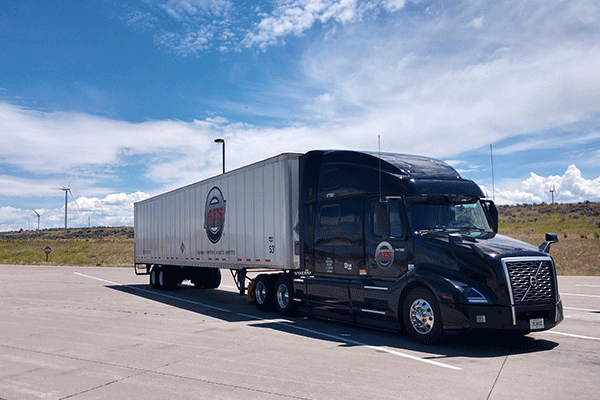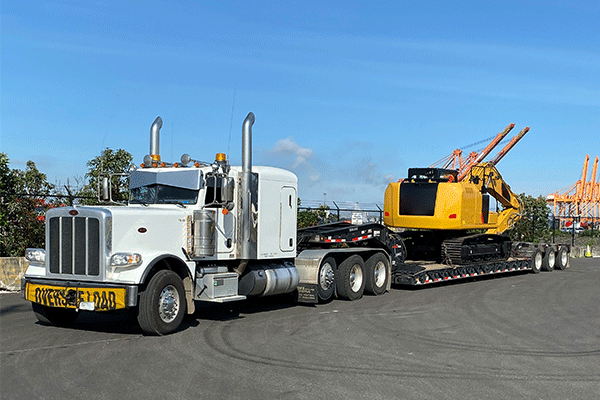
To say the transportation industry is complex would be an understatement. It’s incredibly dynamic and there are literally hundreds of words and phrases that, unless you’re consistently moving freight, you never use.
As such, making your start in this industry or working with it from the outside can be confusing and, frankly, a little intimidating.
Here at ATS, we take pride in using our expertise to educate shippers, consignees and industry stakeholders of all types. From multi-stop shipping to port service charges, we have the knowledge and love to pass it on.
Below, we’ve cataloged and defined the most common acronyms and abbreviations you’ll likely run into when working in this industry for your reference whenever they pop up.
A B C D E F G H J L M N O P R S T U V W
3PL (3rd Party Logistics)
A third-party provider that, through outsourcing, takes over essential elements of another company’s distribution, warehousing and other aspects of their supply chain fulfillment.
AAMVA (American Association of Motor Vehicle Administrators)
A non-governmental association dedicated to maintaining clarity and uniformity across trucking industry guidelines.
BOL (Bill of Lading)
A receipt of freight services that serves as a record of the chain of custody for a shipment. The BOL is a legally binding document providing the driver, carrier, shipper and receiver all the details needed to process a freight shipment and invoice it correctly.
BTS (Bureau of Transportation Statistics)
A branch of the Department of Transportation that’s responsible for acquiring and providing actionable transportation statistics for the DOT across all modes of transport including personal and commercial transportation.
CBP (Customs Border Protection)
An agency of the Federal Department of Homeland Security responsible for monitoring and providing security at the U.S.’ many ports and border crossing points.
CDL (Commercial Drivers License)
The class of driver’s license required to operate a commercial motor vehicle of any kind.
CMV (Commercial Motor Vehicle)
Any vehicle that is used to transport people or property for commercial purposes with a gross weight of more than 10,000 pounds.
COD (Collect on Delivery)
The collection of payment on the freight being shipped upon its arrival. Usually outlined in a shipment's bill of lading.
CPM (Cents Per Mile)
The calculation of a shipment’s cost per mile. Commonly used in conjunction with RPM.
CWT (Hundredweight)
A measurement for the weight of goods that are being purchased and sold. In the United States, one CWT is equal to 100 pounds.
DC (Distribution Center)
The facility dedicated for receiving and distributing quantities of freight to their respective landing spots.
DO (Delivery Order)
A document from a consignee or an owner of freight that orders the release of the transportation of cargo to another party.
DOT (Department of Transportation)
The government body in charge of monitoring the transportation industry as a whole. This includes the movement of freight and people overseas, land and through the air.
ELD (Electronic Logging Device)
Devices located within the cab of a semi-tractor used to record the on-duty hours of a truck driver. ELDs can also be used for load tracking and communication purposes.
FAK (Freight All Kinds)
The term used within the logistics industry when a carrier assigns a single tariff classification for freight that would typically run under several NMFC codes.
FCFS (First-Come-First-Serve)
A type of warehouse operational procedure where the first truck to show up is loaded/unloaded first and all subsequent trucks are serviced according to their arrival order.
 FI (Free-In)
FI (Free-In)
The term used when the handling of the cargo at its port of loading isn’t included in the initial rate quoted to the shipper.
FO (Free-Out)
Whenever the loading and handling of cargo at its port of destination isn’t included in the initial freight rate quoted to the receiver.
FTL (Full-Truckload)
When the entire capacity of a trailer is used by a single shipper, FTL transportation services are being used.
FHWA (Federal Highway Administration)
The branch of the Department of Transportation charged with overseeing and assisting states with the construction and maintenance of highways, interstates and federally owned roads.
FMCSA (Federal Motor Carrier Safety Administration)
The branch of the Department of Transportation responsible for monitoring and promoting the safety practices of commercial motor carriers.
FSC (Fuel-Surcharge)
A fee added, by a carrier, to the cost of a freight shipment to account for variations in fuel prices.
GAWR (Gross Axle Weight Rating)
A number depicting the total amount of gross distributed weight each axle of a trailer can support from the front axles to the rear axles. This includes the weight of your trailer and the cargo it is supporting.
GCWR (Gross Combined Weight Rating)
The total amount of weight a vehicle can safely haul, including the weight of the vehicle itself.
GRI (General Rate Increase)
The adjustment of pricing for a service type from one period of time to another. Often GRIs happen from one year to the next where carriers, for example, adjust the general price of securing capacity.
GVW (Gross Vehicle Weight)
The total weight of a vehicle including the tractor, trailer and cargo in transit.
GVWR (Gross Vehicle Weight Rating)
The total amount of weight that a vehicle can safely transport including the weight of the tractor, trailer and the sum total of freight in transit.
HOS (Hours of Service)
The amount of time, within a 24 hour period, that a truck driver is allowed to be actively on duty according to FMCSA safety regulations. A trucker’s HOS clock allows 14-straight hours of on-duty time.
JIT (Just in Time)
This is a freight delivery operational practice where goods are delivered only as they’re needed. JIT helps organizations get a handle on their inventory and its distribution.
LCL (Less-Than-Container Load)
A term used when the freight hauled is smaller than the full capacity of the container it is transported internationally in.
LI (Liner-In)
The freight rate quoted to the shipper includes all of the cargo handling and loading fees incurred at the port of loading.
LOLO (Lift-On/Lift-Off Cargo)
Cargo lifted on and off vessels and other vehicles using handling equipment.
LO (Liner-Out)
The freight rate quoted to the receiver includes all of the cargo handling and unloading fees incurred at the port of destination.
LOH (Length of Haul)
The total distance of a freight shipment. This is typically broken down into distances of: short-haul, mid-haul, tweener, long-haul and extended-long haul.
 LSP (Logistics Service Provider)
LSP (Logistics Service Provider)
A 3rd party provider of supply chain logistics services.
LTL (Less-Than-Truckload)
A term used when the freight hauled is smaller than the full capacity of the truck carrying it. LTL sizes are variable but are typically capped at 24 feet and 10,000 pounds.
MC (Motor Carrier)
The individual trucker charged with moving a freight shipment from its origin to its destination in exchange for payment.
NHS (National Highway System)
Formed in 1995, the NHS is the collective network of highways spanning the U.S. with a total distance of 160,955 miles.
O/O (Owner Operator)
A trucker who owns and operates their own truck and trailer outside of a larger corporation.
OTR (Over-the-Road)
A method of shipment where a trucker spends a prolonged length of time moving freight over long distances. OTR is commonly associated with hauls measuring greater than or equal to 1,200 miles.
OS&D (Over, Short and Damaged)
Markings used on the bill of lading to signify that, at its destination point, a shipment was either: greater in quantity than specified (over), fewer in quantity than specified (short) or damaged in some way.
OSOW (Oversize/Overweight)
When a vehicle or its freight exceeds the legal maximum dimensions for width, length, height and weight the shipment is considered OSOW.
PAPS (Pre-Arrival Processing System)
An electronic data integration system designed to speed up the documentation review process when transporting goods to the United States from Canada.
PARS (Pre-Arrival Review System)
An electronic data integration system designed to speed up the documentation review process when transporting freight to Canada from the United States.
PO (Purchase Order)
A commercial document issued by a buyer to a seller indicating types, quantities and agreed prices for products or services.
POC (Point of Contact)
The individual in charge of responding to questions and providing support for a given freight shipment. In many cases, shippers are given a single point of contact from their transportation provider.
POD (Proof of Delivery)
The method for proving that the recipient of shipment received the freight following its transit. Often, the bill of lading serves as a shipment’s final POD. Upon delivery, truck drivers must present this POD to receive payment for their services.
POE (Port of Entry)
The international port where a marine cargo shipment is received at its destination country.
POL (Port of Loading)
The international port where a marine cargo shipment is loaded while still in its country of origin.
PTL (Partial-Truckload)
The freight quantity classification between less-than-truckload and full-truckload where freight typically weighs greater than 8,000 pounds.
RFID (Radio-Frequency Identification)
A form of wireless communication used to relay information electronically. RFID-equipped vehicles can sometimes be required to access various ports and terminals.
RFP (Request for proposal)
The process where a company announces an upcoming project including it’s requirements and timelines so that they can collect bids from solution providers (i.e. a shipper looking for trucking solutions).
RFQ (Request for Quote)
A process in which a company requests suppliers and contractors to submit price quotes and bids for the chance to fulfill a specific shipment or project.
RGN (Removable Gooseneck)
A type of trailer with a detachable front portion. The remainder of these trailers can be placed on the ground to create a ramp used for loading/unloading large machinery and other self-propelled freight.

RORO (Roll-on/Roll-Off Cargo)
Cargo that is rolled on and off vessels and other vehicles via ramp or platform.
RPM (Rate Per Mile)
Rate Per Mile (RPM) is trucking industry jargon regarding the pricing of a shipment on a per-mile basis.
SCAC (Standard Carrier Alpha Code)
The (two to four-letter) code given to uniquely identify each freight carrier in the transportation world. Each carrier is given an SCAC by the National Motor Freight Traffic Association.
SKU (Stock Keeping Unit)
An SKU is a unique code consisting of letters and numbers that uniquely identifies a product. SKUs are used by manufacturers and retailers to identify and track their inventory.
SOW (Statement of work)
The document that’s used to describe and define the specifics of a project’s requirements on the part of the service provider (trucking company or brokerage). This includes all deliverables and timelines related to the performed service.
TONU (Truck Order Not Used)
An accessorial charge that’s applied when a shipper is unable to utilize the truck that they ordered. This charge ranges based on how much a trucker is inconvenienced by these issues.
UFC (Uniform Freight Classification)
The process of classifying goods that need to be transported based on certain criteria such as type, quantity, value and perishability.
VMT (Vehicle Miles of Travel)
The total number of miles a vehicle travels in one year.
WIM (Weigh-in-Motion)
Weigh-in-motion systems are designed to capture the gross and individual axle weight of a vehicle as it passes over these areas while in transit.
How to Use These Acronyms
Each of these acronyms plays a unique role in the overall landscape of this industry.
From the BOL to TONU, if you stick around long enough, you’ll run into each and every one of them. That said, you certainly shouldn’t feel the need to memorize these transportation acronyms all at once.
Bookmark this page so that you have these acronyms at the tip of your fingers for a quick reference going forward. We promise to keep them up to date so that, should you need to know the definition of something, it’ll be right here waiting.
ATS has a long history of helping shippers around the world meet their deadlines and achieve their goals. If you’d like more information on how ATS will fit your supply chain, please reach out.




